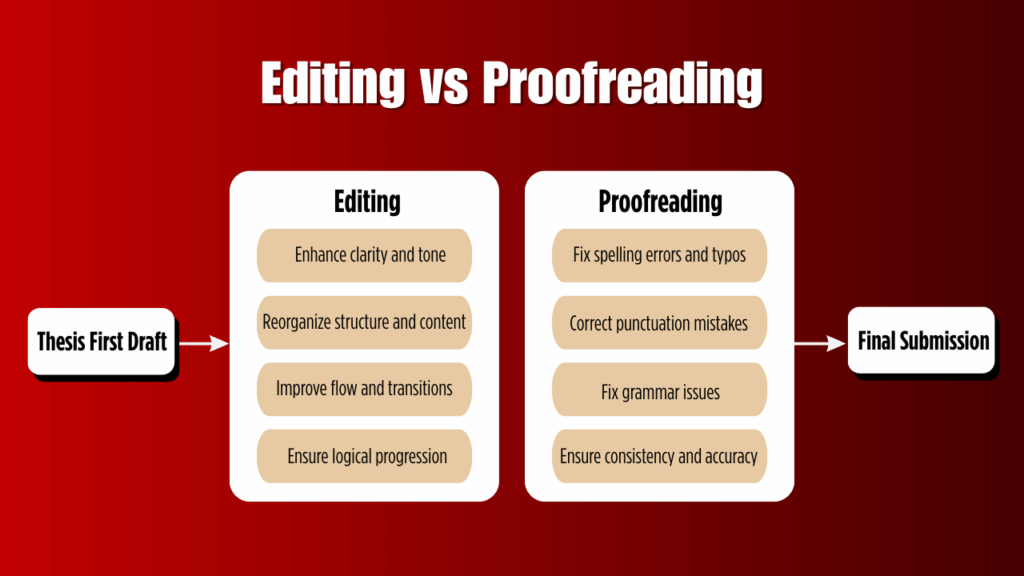Editing vs Proofreading: What Your Thesis Really Needs?
Kenfra Research - Bavithra2025-11-21T17:12:48+05:30When you’re working on your thesis, two key steps are essential for a flawless final submission: editing and proofreading. While both processes aim to improve your writing, they are different in their approach and purpose. Understanding the difference between editing and proofreading is crucial for making sure your thesis is not only error-free but also clear, well-structured, and polished. In this article, we’ll break down what each process involves, when to do them, and why both are necessary for academic success.
What is Thesis Editing?
Thesis editing vs proofreading which process should you start with? Editing is a deeper process that goes beyond fixing small mistakes. When you edit your thesis, you work to enhance the overall quality by reorganizing ideas, improving clarity, and strengthening the logical flow. Editing is about making your research paper more effective and more readable, ensuring that your arguments are presented clearly.
During the editing stage, you’ll focus on:
- Enhancing clarity by simplifying complicated language.
- Reorganizing content to make your thesis more coherent.
- Improving transitions between sections and paragraphs.
- Ensuring logical flow in your arguments and analysis.
Remember, editing vs proofreading requires two different mindsets: editing is about big-picture changes, while proofreading is about catching the small stuff.
What is Thesis Proofreading?
Once you’ve finished editing, the next step in editing vs proofreading is proofreading. Proofreading is a meticulous process that focuses on correcting surface-level mistakes. These can be small, like spelling errors or missing punctuation, but they are still important in presenting a polished thesis.
Proofreading typically involves:
- Checking for spelling errors and typos.
- Correcting punctuation mistakes (e.g., commas, periods).
- Fixing grammar issues, such as incorrect subject-verb agreement.
- Ensuring consistency in citation and formatting.
While editing focuses on improving the content, proofreading is the final step before submission, ensuring that your work is free from distracting errors.

The Difference Between Editing vs Proofreading
While both editing vs proofreading serve important roles in refining your thesis, they focus on different aspects of the writing process:
- Editing involves reviewing your thesis for structure, clarity, and flow. It aims to improve the overall quality of the writing.
- Proofreading focuses on catching minor errors like spelling and punctuation mistakes.
In essence, editing vs proofreading is like preparing a piece of artwork: editing is like reshaping the sculpture, while proofreading is like cleaning up the final details to make sure everything is pristine.
Why Your Thesis Needs Both Editing and Proofreading?
It’s tempting to think that proofreading alone will be enough to perfect your thesis, but both editing and proofreading are crucial. Here’s why:
- Editing ensures clarity and coherence, making your arguments easier to follow and your thesis more impactful.
- Proofreading eliminates small errors that can distract from the quality of your writing and affect how your thesis is perceived.
Both processes work together to ensure your thesis is not only clear and well-organized but also polished and professional. Skipping either one can result in a thesis that doesn’t meet academic standards.
When Should You Edit and Proofread Your Thesis?
The best approach to editing and proofreading is to follow a step-by-step process:
Stage 1: Editing
After completing your first draft, the first task is to edit the content. You’ll look at the thesis as a whole, ensuring that your arguments are clear, your structure is logical, and your ideas are well-presented. Editing may take several rounds, as you refine your writing and improve the overall quality.
Stage 2: Proofreading
Once you’ve made all the necessary edits and are happy with the content, you should move on to proofreading. This step involves reading through the document carefully to find and correct any spelling, grammar, or punctuation errors. Proofreading should be done only after editing is complete, as it’s important to ensure the content is solid before focusing on surface-level mistakes.
Common Mistakes to Avoid When Editing and Proofreading
When working through the process of editing and proofreading, it’s easy to make some common mistakes. Here are a few to watch out for:
- Not editing thoroughly enough: If you rush through the editing process, your thesis may lack clarity and structure, even if it’s free from spelling errors.
- Proofreading too early: Don’t rush into proofreading before you’ve finished editing. You could end up wasting time correcting small mistakes that might change as you revise the content.
- Overlooking formatting: Even if your content is perfect, sloppy formatting can give your thesis an unprofessional appearance.
- Relying too heavily on tools like spellcheck: While spellcheck can catch some errors, it often misses context-based mistakes or incorrect word choices.

Frequently Asked Questions (FAQs) about Editing and Proofreading
Q1: What’s the difference between editing and proofreading?
Editing focuses on improving the structure, clarity, and flow of your thesis, while proofreading is about catching minor errors in spelling, punctuation, and formatting.
Q2: How many rounds of editing should I do?
It’s recommended to edit your thesis at least twice: once for overall structure and clarity, and once for specific details like wording and transitions. You may need more rounds if you find areas that need improvement.
Q3: Can I proofread my own thesis?
Yes, you can proofread your own thesis, but it’s helpful to have someone else review it as well. Fresh eyes can catch mistakes you might have missed.
Q4: How long should I spend proofreading my thesis?
Proofreading can take several hours, depending on the length of your thesis. It’s a detailed process, so it’s essential to give yourself enough time to go through it carefully.
Conclusion:
In conclusion, editing and proofreading are both essential processes that you should never skip when preparing your thesis. Editing ensures that your content is clear, logical, and well-structured, while proofreading makes sure that your thesis is free from small errors. Both steps help to ensure that your thesis meets academic standards and presents your research in the best possible light.
If you need professional help with editing and proofreading your thesis, Kenfra Research—the best PhD provider in Kanyakumari—is here to assist you. We offer expert PhD support services, including comprehensive editing and proofreading, to help you perfect your thesis and achieve academic success.








Leave a Reply